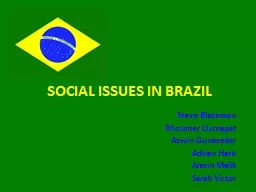

Steve Blackmon Rhoumer Dumapat Aswin Gunasekar Adrian Harb Amrin Malik Sarah Victor SOCIAL ISSUES IN BRAZIL Pobreza Questões raciais Gangues Drogas Educacao SOCIAL ISSUES IN BRAZIL ID: 465155
Download Presentation The PPT/PDF document "SOCIAL ISSUES IN BRAZIL" is the property of its rightful owner. Permission is granted to download and print the materials on this web site for personal, non-commercial use only, and to display it on your personal computer provided you do not modify the materials and that you retain all copyright notices contained in the materials. By downloading content from our website, you accept the terms of this agreement.
Slide1
SOCIAL ISSUES IN BRAZIL
Steve BlackmonRhoumer DumapatAswin GunasekarAdrian HarbAmrin MalikSarah VictorSlide2
SOCIAL ISSUES IN BRAZIL
Pobreza Questões raciaisGangues/Drogas EducacaoSlide3
SOCIAL ISSUES IN BRAZIL
Pobreza (Poverty)Questões raciais (Racial Issues)Gangues/Drogas (Youth gangs and drugs)Educacao (Education)Slide4
RACE & ETHNICITY IN BRAZIL
Indigenous populations: Tupi, Ewe, and Ge1500’s: Portuguese Settlers and African populationsLate 1800’s – 1900’s: Italian, Spanish, German, Japanese, Middle East, and Eastern EuropeSugar cane crops, gold and diamonds = increased slave trafficking
Last country in the Americas to end slavery (1888)Slide5
SOCIAL APARTHEID
IndicatorsWhite BrazilianBlack BrazilianIlliteracy5.9%13.3%University Degree15.0%
4.7%
Life Expectancy
73.13%
67.03%Unemployment5.7%
7.1%
GDP Per
Capita
R$ 22,699
R$ 15,068
Homicide Deaths
29%
65.5%Slide6
THE FUTURESlide7
POVERTY
Most visually represented by Favelas In part attributed to economic inequality> 50% of population lacks resources for basic survivalPoor segment is 33% of population. Extremely poor is 13%Richest 10% receive 42% of nation's incomePoorest population receives < 1.2% of nation’s incomeSlide8
GINI COEFFICIENT
0 perfect income equality 1 maximal inequality Gini-coefficient of national income distribution around the world (using 2009 info)Slide9
POVERTY MITIGATION & OUTLOOK
Fight extreme poverty and income inequalityPublic policies of social interventionIncreased social spending (21.9% in 2005)Decentralization of social policy Municipalities share of social spending rose 53.8% from 1980 to 2008‘Zero Hunger’ program ‘Bolsa Familia’Reach social indicators of developed countries by 2016Projected poverty rate of 4%Slide10
YOUTH GANGS & DRUGS
Drug gangs control majority of favelas around cities.Gangs recruit children as young as 10 to run/sell drugs.Kids can earn up to $150/day.Slide11
Brazil
USSlide12
YOUTH PROGRAMS & EDUCATION
Locally/internationally sponsored youth programs are helping break the low poverty/education cycle.+Oportunidades program is preparing kids for a brighter future through education and training.Slide13
REVIEW OF THE EDUCATION SYSTEM
Primary EducationFree for all Most elementary schools maintained by municipalities or the StatesRicher cities have better schools due to better tax revenueBiggest problem is non attendance due to malnutrition, children working and high examination failure rateStandards falling, middle class turn to private schools further making public schools worseOfficial programs that have worked
well:
Bolsa
Escola; now rolled into Bolsa Familia,
FUNDEFSlide14
SECONDARY EDUCATION
Not mandatory in BrazilMost intermediary schools are maintained by the municipalities and StatesAccess to University based mainly on merit, measured by performance in ENEM (previously called 'vestibular’)Private schools prepare students better for University Students who could afford the best intermediary schools or
cursinhos
approved into the free public universities
Inherent handicap for poor studentsSlide15
HIGHER EDUCATION
Majority of federal education funds goes towards public universitiesBetter lobbying powerPublic universities are best in qualityUniversidade Federal do Rio de Janeiro
Universidade de São Paulo
Universidade de
Brasília
Have funds needed for investments in Medicine and Engineering programsPrivate universities offer Human Sciences,
Administration
,
AccountsSlide16
OUTLOOK
Some notable successes700,000 scholarships for low income students180 vocational schools compared to 140 and 93 over that last 2 yearsSchool enrollments climbing, Middle school graduation rate risen from 34% to 47%Yet, Education - the biggest disadvantage for Brazil compared to China, India & RussiaMore than 22 percent of the roughly 25 million workers available to join Brazil’s work force in 2011 were not considered qualified to meet the demands of the labor
market
Many parents say, ‘Why should they study if there are no opportunities?’
‘Unless that gap is filled soon, Brazil may miss its demographic window over the next two decades in which the economically active population is at its peak’ - World
BankSlide17
OBRIGADO!